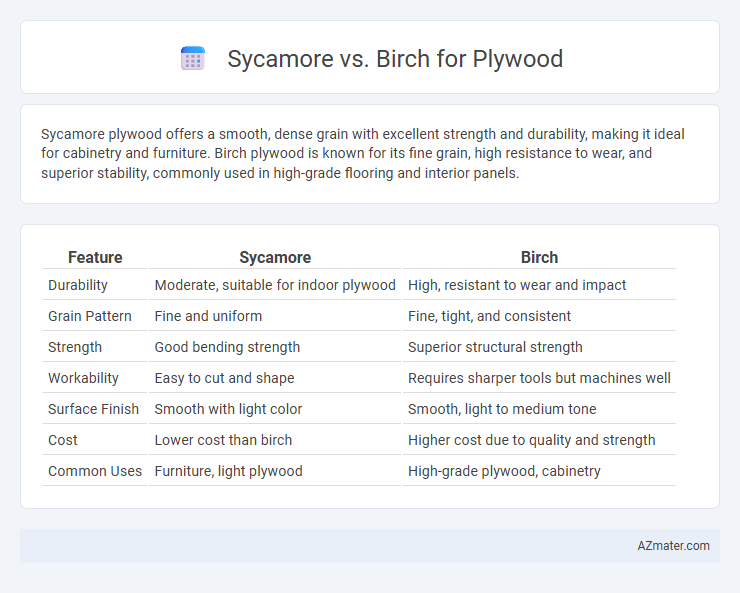Sycamore plywood offers a smooth, dense grain with excellent strength and durability, making it ideal for cabinetry and furniture. Birch plywood is known for its fine grain, high resistance to wear, and superior stability, commonly used in high-grade flooring and interior panels.
Table of Comparison
| Feature | Sycamore | Birch |
|---|---|---|
| Durability | Moderate, suitable for indoor plywood | High, resistant to wear and impact |
| Grain Pattern | Fine and uniform | Fine, tight, and consistent |
| Strength | Good bending strength | Superior structural strength |
| Workability | Easy to cut and shape | Requires sharper tools but machines well |
| Surface Finish | Smooth with light color | Smooth, light to medium tone |
| Cost | Lower cost than birch | Higher cost due to quality and strength |
| Common Uses | Furniture, light plywood | High-grade plywood, cabinetry |
Introduction to Sycamore and Birch Plywood
Sycamore plywood offers a smooth, fine grain surface ideal for high-quality furniture and cabinetry, known for its durability and resistance to splitting. Birch plywood features a strong, dense wood with consistent grain, commonly used in flooring, plywood panels, and cabinetry for its excellent strength-to-weight ratio. Both Sycamore and Birch plywood provide reliable structural performance, but Sycamore excels in appearance while Birch dominates in strength and versatility.
Botanical and Material Differences
Sycamore plywood, derived from trees in the genus Platanus, features a fine, uniform grain with a pale, creamy color, offering excellent stability and smooth surface ideal for decorative veneers. Birch plywood, sourced from the Betula genus, is known for its strength, dense grain, and creamy white to light brown hue, providing superior durability and resistance to wear. The botanical differences influence material properties: Sycamore's softer wood enables easier cutting and shaping, while Birch's harder texture ensures enhanced structural integrity and longer lifespan in plywood applications.
Appearance and Grain Patterns
Sycamore plywood features a fine, uniform grain with subtle, creamy tones, creating a smooth and consistent surface ideal for modern and minimalist designs. Birch plywood displays a more prominent grain pattern with a light, pale color and occasional small knots, offering a natural, rustic aesthetic suited for traditional or farmhouse styles. Both woods provide a visually appealing finish, but sycamore's delicate grain contrasts birch's more textured and varied appearance.
Strength and Durability Comparison
Sycamore plywood offers superior strength with a fine, even grain that enhances load-bearing capacity, making it ideal for structural applications. Birch plywood is known for exceptional durability due to its dense, hard fibers that resist impact and wear, providing long-lasting performance in high-traffic environments. When comparing strength and durability, birch plywood tends to outperform sycamore in resistance to abrasion, while sycamore excels in flexibility and tensile strength.
Workability and Machining
Sycamore plywood offers excellent workability due to its fine, uniform grain, making it ideal for detailed machining and smooth finishes. Birch plywood, known for its hardness and strength, machines well but requires sharper tools to prevent burnishing and tear-out on edges. Both provide durable surfaces, yet Sycamore tends to be easier for intricate cutting and shaping tasks in woodworking projects.
Cost and Availability
Sycamore plywood generally costs more than birch plywood due to its finer grain and limited availability, making it a premium choice for detailed woodworking projects. Birch plywood is widely available and produced in large quantities, which helps keep its price competitive and accessible for various applications. Both types offer strong durability, but birch remains the more economical and readily found option in most markets.
Environmental Impact and Sustainability
Sycamore plywood offers a higher sustainability profile due to its faster growth rate and greater abundance, resulting in more efficient carbon sequestration compared to Birch plywood, which derives from slower-growing trees with denser wood. Birch plywood, while durable, often requires more energy-intensive harvesting and processing methods, increasing its overall environmental footprint. Choosing Sycamore plywood supports sustainable forest management practices by reducing deforestation pressure and promoting renewable resource utilization.
Common Applications and Uses
Sycamore plywood is widely used in furniture manufacturing, cabinetry, and decorative paneling due to its fine grain and smooth finish, which allow for excellent staining and painting results. Birch plywood, known for its strength and durability, is commonly utilized in flooring, structural applications, and high-end furniture where stability and resistance to wear are crucial. Both woods offer versatility, but birch plywood often outperforms in load-bearing projects, while sycamore excels in aesthetic-focused applications.
Finishing and Maintenance Considerations
Sycamore plywood offers a smooth, fine grain that absorbs stains evenly, making it ideal for high-quality finishing with clear coats or paints, while birch plywood features a consistent grain pattern that also takes finishes well but typically requires sealing to prevent blotching. Sycamore tends to be softer and may show wear more quickly, necessitating more frequent maintenance or protective coatings in high-traffic applications, whereas birch provides greater durability and resistance to dents, reducing long-term upkeep. Choosing between sycamore and birch for plywood depends on balancing desired aesthetic effects with maintenance commitments, especially in furniture or cabinetry exposed to moisture or heavy use.
Choosing the Right Wood for Your Project
Sycamore plywood offers a fine, uniform texture and excellent strength, making it ideal for cabinetry, furniture, and interior paneling where smooth finishes matter. Birch plywood is known for its durability, resistance to warping, and attractive grain, making it suitable for flooring, structural applications, and high-quality veneers. Selecting the right wood depends on project requirements: choose sycamore for refined aesthetics and birch for robust, long-lasting performance.

Infographic: Sycamore vs Birch for Plywood
 azmater.com
azmater.com